You are using an out of date browser. It may not display this or other websites correctly.
You should upgrade or use an alternative browser.
You should upgrade or use an alternative browser.
Russian Military News, Reports, Data, etc.
- Thread starter tphuang
- Start date
The article cites RIA Novosti which notes that construction of VLO corvette Project 20386 "Derzhky" has been suspended and the project has been moved to a redesign phase to address ongoing problems. What it really means is that as predicted the ship will never be finished in its intended configuration and if it ever enters service it will be only as an experimental test vessel.
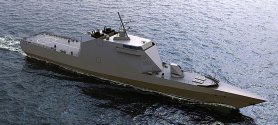
The project has been in development for close to 10 years at the cost of 29 billion Rubles which is approx. 850-900 million USD at pre-sanction exchange rate! As such the project is a significant failure with very little to show for.
It was laid down in October 2016 in Northern Shipyard (Severnaya Verft) in St.Petersburg and launched in March 2021. From the beginning it was plagued by numerous problems because of the ambitious nature of the project, among them composite superstructure to achieve VLO characteristics. However it was doomed from the start due to the use of 20380/Steregushchiy hull to speed up design and construction. The decision was made based on the use of the same hull for the 20385/Gremyashchiy class of corvettes but those had minimal changes compared ot the original. The small base hull - 104m long, 13m wide, sufficient for a 2500t corvette - despite changes shown on the image below imposed limitations on volume and stability for an intended 3400+ t ship which is where all the current problems with radars, insufficient VLS number or helo lift and hangar come from.
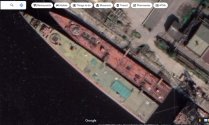
There was no way the ship could ever succeed but the project was continued as means of ensuring funding for the shipyard and R&D. 20386 is too small for all the intended design solutions to be feasible, and that is caused directly by poor ship design and naval traditions of Russia and the Soviet union which had jeune ecole mentality imposed by land and air force interest in the military. This is why Russia doesn't have the facilities or expertise to design and build large surface vessels which limits its ability to innovate in terms of hull structure at acceptable cost and confines production to long series of tested designs of small volume and displacement.
Interestingly the ship's original name "Merkuriy" has been assigned to a new 20380 corvette which in May entered service with the Black Sea Fleet.
----
This leads me to the deteriorating condition of current shipbuilding programs for submarines and large surface vessels.
The last column is commissioning date from mid-2022, compare with the preceding column indicating new dates per 2023. The red crosses indicate delay in years - red is for ships already laid down, light red is for ships not yet laid down. Data from navy-korabel.livejournal.com.
- 955A - Borei SSBN
- 885M - Yasen SSGN
- 677 - Lada SSK
- 636.3 - Imp. Kilo SSK
- 22350 - Adm. Gorshkov FFG
- 20385 - Gremyashchy FFC
- 20380 -Steregushchiy FFC
- 23900 - Priboy LHD
- 11711 - Ivan Gren LPD

All the delays have been caused by failure of Russian military operation in Ukraine in 2022, so any further delay stemming from events in 2023 and later are not yet included. It is however very likely that further delays will occur considering all the material effort necessary to sustain ongoing military operations and replenishment of materiel in land and air force which account for almost all of the losses. "Derzhkiy" with two years delay on the above list is only the first and most obvious casualty.
From above list - large surface combatants:
22350 FFG: 4x Pacific, 4x Northern, 2x ?, currently none for Black Sea
20385 FFC: 6x Pacific, 2x Northern
20380 FFC: 2x Black Sea, 3x Pacific, 2x Northern
additionally - minor vessels:
22800 FAC: 4x Pacific, 3 or 5x Black Sea, 6 or 4x Baltic
21631 FAC: 1x Baltic, 1x Caspian
Those are current plans until 2029/31. Afterward SSBN and SSGN productio should be shifted to SSN replacement and surface production will likely be continued at the current rate if funds are available.
The most difficult situation is developing in the Baltic - since Finland's accession, technically already a NATO lake. Baltic Fleet has only four relatively modern Steregushchiy coastal corvettes (14 days autonomy) of which only three have Redut SAM system (naval S-350). These are complemented by obsolete 1980s designs - one 30yo. (956) Sovremenny DDG and two (11540) Neustrashimy ASW frigates based on Krivak class. No replacement is currently planned. The main surface force are Karakurt (22800) and Buyan-M (21631) coastal missile boats with poor air defenses. The ASW force of 2x 11540s and 4x 20380 is supported by 6x obsolete 30+ y.o. 1331M Grisha clones with no replacement planned. The addition of four (or more) largely obsolete Imp.Kilo SSKs without AIP will not change the situation. The fleet is based on Baltiysk in Kaliningrad Oblast and Kronshtadt, St.Petersburg. The distance between these two bases is close to 1000km where poorly defended vessels will maneuver in a closed body of water controlled by the enemy on all sides. Enemy territory is also barrier to air force and Kaliningrad is covered by enemy fires land/air/sea. Game over for Russia on strategic, operational and tactical levels. At this point secession of Kaliningrad - an isolated, impoverished (7800EUR per capita, ~1/3 of Lithuania's) exclave of ~1 million people - becomes a viable play and should be expected in the coming years as it would resolve a crucial security flaw for EU/NATO.
Northern and Pacific fleet are in worse technical condition presently but have ongoing replacement for large surface combatants and both conventional and nuclear submarines. While their strength will be much reduced they will be still relatively capable at sea.
Black Sea fleet has largely completed modernisation and is in best condition, including having real combat experience. While unable to meaningfully project power beyond Black Sea it is a viable threat inside it - with or without Crimea - as a defensive formation backed by air force and coastal defenses.
----
Current status of the submarine fleet as of 1st June from:
I omitted the surface fleet because it's almost all active with no irregularities. But submarines:

Surprisigly almost all SSNs are out of service currently! Their roles are not easily filled by SSGNs, especially the much louder Oscars. Pacific fleet is particularly weakened, even with the newly introduced Krasnoyarsk (885M).
----
Also in other news:
The contract for 24 Su-34NVO from June 2020 is nearing completion in 2023 at 20 airframes delivered as of the latest batch with 6 delivered in 2021, 10 in 2022 and likely 4 in the recent batch. Production should be finished by the end of 2023.
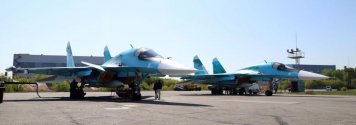
Su-34NVO is manufactured in Novosibirsk (NAPO) plant which also conducts repairs to Su-24s which are going to be returned to service for new aviation regiments (per Dec 22 plan) but that shouldn't delay production of Su-34.
The losses of Su-34 in Ukraine so far are estimated at ~21 airframes excluding aircraft damaged but returned to base. That's a net loss of 3+ years of industrial effort past funding peak of 2014-17.
It's important to note that Su-34NVO is a reduced-scope modernisation of base Su-34 design which doesn't change the inherent flaws of the aircraft - large RCS metal airframe, outdated systems architecture, old PESA radar etc. Newly produced Su-34NVO are equivalent to modernised F-15E w/o AESA, approx. one generation behind J-16. New units will still have to fly restored Su-24M2.
Any arguments for increase of production in either aircraft or ships should first consider the (up to now) losses of ~2000+ mbt, ~3400+ ifv/apc which are definitely a priority. This means that for several years the navy and the air force will continue with current plans and it should be considered a success if these plans are achieved as it is very likely - based on historical precedent - that they will be revised in coming years due to inevitable shortage of funds and that is without considering the ongoing expenditures for continued military operations in Ukraine meaning that even if Russia withdrew from Ukraine tomorrow it would have to address all the other issues first which would take a number of years.
how you know losses of Su-34. and current war time production rate.. and what is inside electronics of Su-34NVOSu-34NVO is manufactured in Novosibirsk (NAPO) plant which also conducts repairs to Su-24s which are going to be returned to service for new aviation regiments (per Dec 22 plan) but that shouldn't delay production of Su-34.
The losses of Su-34 in Ukraine so far are estimated at ~21 airframes excluding aircraft damaged but returned to base. That's a net loss of 3+ years of industrial effort past funding peak of 2014-17.
It's important to note that Su-34NVO is a reduced-scope modernisation of base Su-34 design which doesn't change the inherent flaws of the aircraft - large RCS metal airframe, outdated systems architecture, old PESA radar etc. Newly produced Su-34NVO are equivalent to modernised F-15E w/o AESA, approx. one generation behind J-16. New units will still have to fly restored Su-24M2.
The word advanced in 2023 not have same meaning as advanced in year 2006.
it says increase range against naval targets and expand conditions and accuracy. it could be some thing like sea drones or small targets with smaller bombs. The bombers come from the factory with 3000L tank and EW pods.
"The Su-34 features extended combat capabilities, enabling it to employ advanced air-launched munitions, increase the range of striking ground and naval targets and expand the conditions and accuracy of bombing runs," the statement reads.
Russian statements should not be taken at face value due to deception but one way look at it is how third parties see Russia. A plane parked like this in Saudi is either a command center or people who dont want to show faces. Saudi is country that has spent more on Western military Airpower outside US than any one else. they have good idea where things stand at technical level.
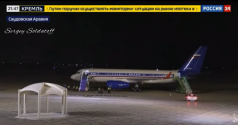
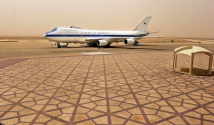
Batch ? 20 ?Defense contractor delivers new batch of Su-34 frontline bombers to Russian troops
It was stressed that Su-34 frontline bombers are a major part of the Russian frontline aviation’s strike power
MOSCOW, June 1. /TASS/. The United Aircraft Corporation (UAC, part of the state tech giant Rostec) has delivered a new batch of Su-34 frontline bombers to Russia’s Aerospace Forces, the UAC press office reported on Thursday.
"The UAC has delivered a new batch of Su-34 frontline bombers to the Russian Aerospace Forces. These splendid aircraft have been manufactured at the Chkalov Novosibirsk Aviation Plant. The planes have undergone a set of ground and flight tests and have been delivered to the Defense Ministry of Russia," the press office said in a statement on its Telegram channel.
"The Su-34 features extended combat capabilities, enabling it to employ advanced air-launched munitions, increase the range of striking ground and naval targets and expand the conditions and accuracy of bombing runs," the statement reads.
"Su-34 frontline bombers are a major part of the Russian frontline aviation’s strike power," the press office stressed.
Project 20386 suffers from the same issue as Project 22160. Someone in the Russian Navy wanted to copy US' failed approach with LCS program. Both ships were intended to have minimal equipment fitted standard, and were supposed to rely on modules, which were supposed to be containerized. This is the reason why these ships lack armament. Failure of these designs has nothing to do with lack of capabilities of Russian design of large ships, shipbuilding, or whatever you are talking about. The fact it uses composite superstructure is not the cause for suspension either. Project 20380/5 also uses composite superstructure, as do other Russian ships.The article cites RIA Novosti which notes that construction of VLO corvette Project 20386 "Derzhky" has been suspended and the project has been moved to a redesign phase to address ongoing problems. What it really means is that as predicted the ship will never be finished in its intended configuration and if it ever enters service it will be only as an experimental test vessel.
... the project is a significant failure with very little to show for.
It was laid down in October 2016 in Northern Shipyard (Severnaya Verft) in St.Petersburg and launched in March 2021. From the beginning it was plagued by numerous problems because of the ambitious nature of the project, among them composite superstructure to achieve VLO characteristics.
... Russia doesn't have the facilities or expertise to design and build large surface vessels which limits its ability to innovate in terms of hull structure at acceptable cost and confines production to long series of tested designs of small volume and displacement.
The ship design for Project 20386, much like that of Project 22160, proved to have poor cost/effectiveness and overall combat effectiveness. Further construction of those ships was cancelled because of that. Which is much better than what US is doing with LCS. Where they continue to buy LCS despite it being crap.
Thus far there was no cut in funding to the Russian Navy. And the Air Force only had substantial losses in helicopters and Su-25. Other losses are less than a year of aircraft production. Plus you are mixing up your timeline. Russian Navy construction delays were due to sanctions after 2014 Annexation of Crimea, which led to planned purchases of Ukraine gas turbines, and German diesel engines, no longer being an option. How can these failures you discussed, like the one of Project 20386, be attributed to the SMO in 2022, when they happened before it?All the delays have been caused by failure of Russian military operation in Ukraine in 2022, so any further delay stemming from events in 2023 and later are not yet included. It is however very likely that further delays will occur considering all the material effort necessary to sustain ongoing military operations and replenishment of materiel in land and air force which account for almost all of the losses.
The Steregushchiy (22380) corvette is better equipped than many frigates. And the remaining initial corvette of that type is currently being upgraded with Redut. Autonomy is claimed to be 15 days which, in a small body of water like the Baltic where it will operate close to naval bases, is more than sufficient. The Karakurt (22800) corvettes can be upgraded with Pantsir-M for air defense in case they do not come with it already. Pantsir-M is part of the original design, and was not fitted in the initial ships, because it was not available and in serial production back then. But it is now.The most difficult situation is developing in the Baltic - since Finland's accession, technically already a NATO lake. Baltic Fleet has only four relatively modern Steregushchiy coastal corvettes (14 days autonomy) of which only three have Redut SAM system (naval S-350). These are complemented by obsolete 1980s designs - one 30yo. (956) Sovremenny DDG and two (11540) Neustrashimy ASW frigates based on Krivak class. No replacement is currently planned. The main surface force are Karakurt (22800) and Buyan-M (21631) coastal missile boats with poor air defenses.
...
The ASW force of 2x 11540s and 4x 20380 is supported by 6x obsolete 30+ y.o. 1331M Grisha clones with no replacement planned. The addition of four (or more) largely obsolete Imp.Kilo SSKs without AIP will not change the situation. The fleet is based on Baltiysk in Kaliningrad Oblast and Kronshtadt, St.Petersburg. The distance between these two bases is close to 1000km where poorly defended vessels will maneuver in a closed body of water controlled by the enemy on all sides. Enemy territory is also barrier to air force and Kaliningrad is covered by enemy fires land/air/sea. Game over for Russia on strategic, operational and tactical levels.
As for the Grisha replacement, the Steregushchiy is one of the proposed replacement designs, but there are other designs which have been also proposed but not produced yet.
As for the Improved Kilo not having AIP, I do not know why you focus on ship endurance so much, when we are talking about operating in the tiny confines of the Baltic of all places.
The 1000 km distance is not a big issue. Since Russian surface vessels can still support each other. That is within range of both Kalibr and Zircon. Once Kalibr-M (4500 km range) enters service even the ships in the White Sea will be able to cover the whole Baltic and beyond that.
Russia does not bother putting more ships in the Baltic because they know any ships they put there will be highly vulnerable in case of conflict. Basically fish in a barrel. That was their experience back in WW2 against the Nazis where the Soviet Baltic Fleet was decimated. And they have little reason to expect anything different this time. Still, they can move small corvettes and diesel subs in and out of the Baltic if they really need to, through the Unified Deep Water System i.e. their canals which connect the Baltic with the White Sea, the Caspian Sea, and the Azov Sea.
If NATO attacks Kaliningrad they can say goodbye to the Baltics. Whichever way they cut it.At this point secession of Kaliningrad - an isolated, impoverished (7800EUR per capita, ~1/3 of Lithuania's) exclave of ~1 million people - becomes a viable play and should be expected in the coming years as it would resolve a crucial security flaw for EU/NATO.
The Pacific Fleet is in a huge expansion. But the Northern Fleet is way behind in terms of being upgraded or considered a priority even.Northern and Pacific fleet are in worse technical condition presently but have ongoing replacement for large surface combatants and both conventional and nuclear submarines. While their strength will be much reduced they will be still relatively capable at sea.
Some of the Russian ships in the Black Sea lack air defenses and the planned additions of large corvettes won't able to go there because of the Dardanelles being closed in Turkey. But just the submarines are pretty much enough to deny the ships of everyone else.Black Sea fleet has largely completed modernisation and is in best condition, including having real combat experience. While unable to meaningfully project power beyond Black Sea it is a viable threat inside it - with or without Crimea - as a defensive formation backed by air force and coastal defenses.
The Russian attack submarine fleet was considered a lower priority by the government than strategic submarines. So fleet replenishment is severely behind. Because of that the Russian Navy ordered the Project 636.3 Improved Kilos to be built. Of which four are in service in the Pacific fleet already and another two in advanced stage of construction. The shipyard has been delivering a submarine a year. The other five older Kilos are also still being kept in service in the fleet.I omitted the surface fleet because it's almost all active with no irregularities. But submarines
...
Surprisigly almost all SSNs are out of service currently! Their roles are not easily filled by SSGNs, especially the much louder Oscars. Pacific fleet is particularly weakened, even with the newly introduced Krasnoyarsk (885M).
While the lack of attack submarines is indeed a problem, and the program is severely delayed, it is not like they have been sitting on their asses all this time. Project 885M did enter service, and the shipyard facilities have been upgraded so they can build the Laika.
The Russians ordered 76 Su-34Ms in 2020 to be delivered until 2027. That would be a production rate of over 7 aircraft a year. But that is peacetime production and they produced more Su-34 aircraft a year than that at the peak. So "3+ years" is BS. Even if you believe Oryx's numbers on losses.The contract for 24 Su-34NVO from June 2020 is nearing completion in 2023 at 20 airframes delivered as of the latest batch with 6 delivered in 2021, 10 in 2022 and likely 4 in the recent batch. Production should be finished by the end of 2023.
...
Su-34NVO is manufactured in Novosibirsk (NAPO) plant which also conducts repairs to Su-24s which are going to be returned to service for new aviation regiments (per Dec 22 plan) but that shouldn't delay production of Su-34.
The losses of Su-34 in Ukraine so far are estimated at ~21 airframes excluding aircraft damaged but returned to base. That's a net loss of 3+ years of industrial effort past funding peak of 2014-17.
The upgrade adds MAWS to the aircraft. Which will be of help against MANPADS in case they decide to use it to do low altitude attacks again. It also has improved EW capabilities. So it should be more survivable against air defenses in general. The electronics including the radar backplane are also supposedly upgraded. And I do not know what you mean by "outdated systems architecture". Sure it has PESA radar. So what.It's important to note that Su-34NVO is a reduced-scope modernisation of base Su-34 design which doesn't change the inherent flaws of the aircraft - large RCS metal airframe, outdated systems architecture, old PESA radar etc. Newly produced Su-34NVO are equivalent to modernised F-15E w/o AESA, approx. one generation behind J-16. New units will still have to fly restored Su-24M2.
None of the factories for land vehicles produce ships or aircraft. So there is no competition for resources whatsoever.Any arguments for increase of production in either aircraft or ships should first consider the (up to now) losses of ~2000+ mbt, ~3400+ ifv/apc which are definitely a priority.
Russia increased its military budget to take account for the conflict. And while some programs might be cut it is highly unlikely those cuts will impact the conventional forces spending in a significant way. Which more likely than not will be hugely expanded. Let us say they delay or cancel the upgrade of the Peter the Great, delay the Yars-M upgrade, and cut production of the Poseidon carriers. That would be more than enough to fund replacing the lost armored vehicles. The Russians claim that helicopter engine production will be expanded from 400 engines a year to 600 engines a year for example. So production of conventional equipment is already being vastly expanded. At the same time deliveries of aircraft engines to China basically ceased, so now all that factory capacity is available for the Russians to use for themselves.This means that for several years the navy and the air force will continue with current plans and it should be considered a success if these plans are achieved as it is very likely - based on historical precedent - that they will be revised in coming years due to inevitable shortage of funds and that is without considering the ongoing expenditures for continued military operations in Ukraine meaning that even if Russia withdrew from Ukraine tomorrow it would have to address all the other issues first which would take a number of years.
At this point secession of Kaliningrad - an isolated, impoverished (7800EUR per capita, ~1/3 of Lithuania's) exclave of ~1 million people - becomes a viable play and should be expected in the coming years as it would resolve a crucial security flaw for EU/NATO.
Nuclear war will solve all of NATO security flaws indeed. Make sure you have a nuclear fallout shelter nearby, too, at least.
I mean if "improverishment" is a good enough reason for that, maybe Serbia should make a move for Kosovo as they are within their right by your logic.
Military repair and recovery vehicle REM-KL Ural-532362 of Russia, review. The new REM-KL repair and recovery vehicles began to be actively used by the Russian army. The REM-KL vehicle is mounted on a Ural-532362 wheeled chassis. The main purpose of the vehicle is current repairs, assistance to drivers in the maintenance and evacuation of military equipment. The REM-KL vehicle can transport equipment semi-loaded on a special device or simply tow it at a maximum speed of up to 30 km/h on dirt roads and up to 50 km/h on paved roads. For maintenance, REM-KL is equipped with a special body van, it contains the necessary set of equipment and tools. The machine is equipped with an electric generator for welding operations and an IM-95 loader crane with a maximum lifting capacity of up to 2.83 tons. The permissible weight of transported vehicles on dirt roads, with their semi-loading, is up to 16 tons, on paved roads up to 22 tons, with normal towing equipment up to 12 tons. REM-KL can use a winch with a hydraulic drive, the length of the winch cable is 60 meters. Gross vehicle weight 24950 kg, crew 3 people.
Review of Russian destroyers of project 956. The Northern Fleet conducted a comprehensive exercise "Kumzha-2023", during which the sailors demonstrated their combat capabilities and tactics. About fifteen surface vessels, submarines and support ships, as well as aircraft and helicopters of the Air Force and Air Defense Army were involved in the maneuvers. The Russian destroyer "Admiral Ushakov" of project 956-A was spotted at the exercises. The first destroyer of the third generation of project 956 was commissioned in 1980, now Russia has 2 ships of this project and 2 are in reserve. The fate of the ships of this project was not easy, steam boilers on ships of this type required the close attention of the crew, they were demanding on the water supplied and failed if the quality of their service was violated. Unfortunately, due to problems in the fleet in the nineties, some ships of this project actually went only 6 years, with a given service life of more than 20 years. It is worth noting that four Project 956 ships are still part of the Chinese fleet, one of them was built in 1994. The armament of the first ships of this project, 130-mm AK-130 naval artillery mounts, 30-mm AK-630 anti-aircraft artillery systems. Eight P-270 Moskit anti-ship missiles. The Uragan air defense system and two RBU-1000 six-barrel rocket launchers, the ship has two double 533-mm torpedo tubes and a Ka-27 helicopter. The ship at one time was not bad enough, had its weak points, but its time is running out. The total displacement of the ship is 7,904 tons, the cruising range is up to 4,500 miles, and the speed is 33 knots. The autonomy of the vessel is 30 days, the crew is 296 people.
